The Red Devil RX 6900 XT takes on the RTX 3090 in 35 Games , GPGPU & SPEC Workstation Benchmarks – Part 1
The Red Devil RX 6900 XT Limited Edition arrived at BTR for evaluation on a two-week loan from PowerColor the day before Christmas although it launched earlier at $1139 or at $1179 for the Limited Edition. We have been comparing it with the $649 RX 6800 XT reference version and benching it versus the $1499 RTX 3090 Founders Edition (FE) and versus the $699 RTX 3080(FE). We are featuring the Red Devil RX 6900 XT in a three part review, and this Part 1 features 35 games, GPGPU, workstation, SPEC, and synthetic benchmarks. Part 2 will compare 15 virtual reality (VR) games, and Part 3 will focus on overclocking and power draw versus the RTX 3090 FE.

We will also compare the performance of these competing cards with the RX 5700 XT Anniversary Edition (AE) and the GTX 1080 Ti FE to see how older cards fare, and we also include all of the GeForce Turing Super cards and the Ampere cards to complete BTR’s 12-card Big Picture.
The Red Devil RX 6900 XT is factory clocked 90MHz higher than the reference version at 2250MHz using the OC BIOS. According to its specifications, the Red Devil RX 6900 XT boost can clock up to 2340MHz out of the box. It also looks different from older generation classic Red Devils, arriving in a more neutral gray color instead of in all red and black. The Red Devil RX 6900 XT features a RGB mode whose LEDs default to a bright red which may be extensively customized by PowerColor’s DevilZone software.
The Red Devil RX 6900 XT Features & Specifications
The Red Devil RX 6900 XT specifications include an Engine/Game clock of 2105MHz that will Boost up to 2340MHz, and it uses 16GB of DDR6 at 16Gbps on PCIe 4.0. The Game clock is the expected GPU clock while running average high-load gaming scenarios with a regular non-overclocked total graphics usage situation. It’s a high power-draw card, and PowerColor recommends a 900W PSU to power it. We will test the power draw and overclocking in Part 3.
Specifications

Features
Here are the Red Devil RX 6900 XT features.
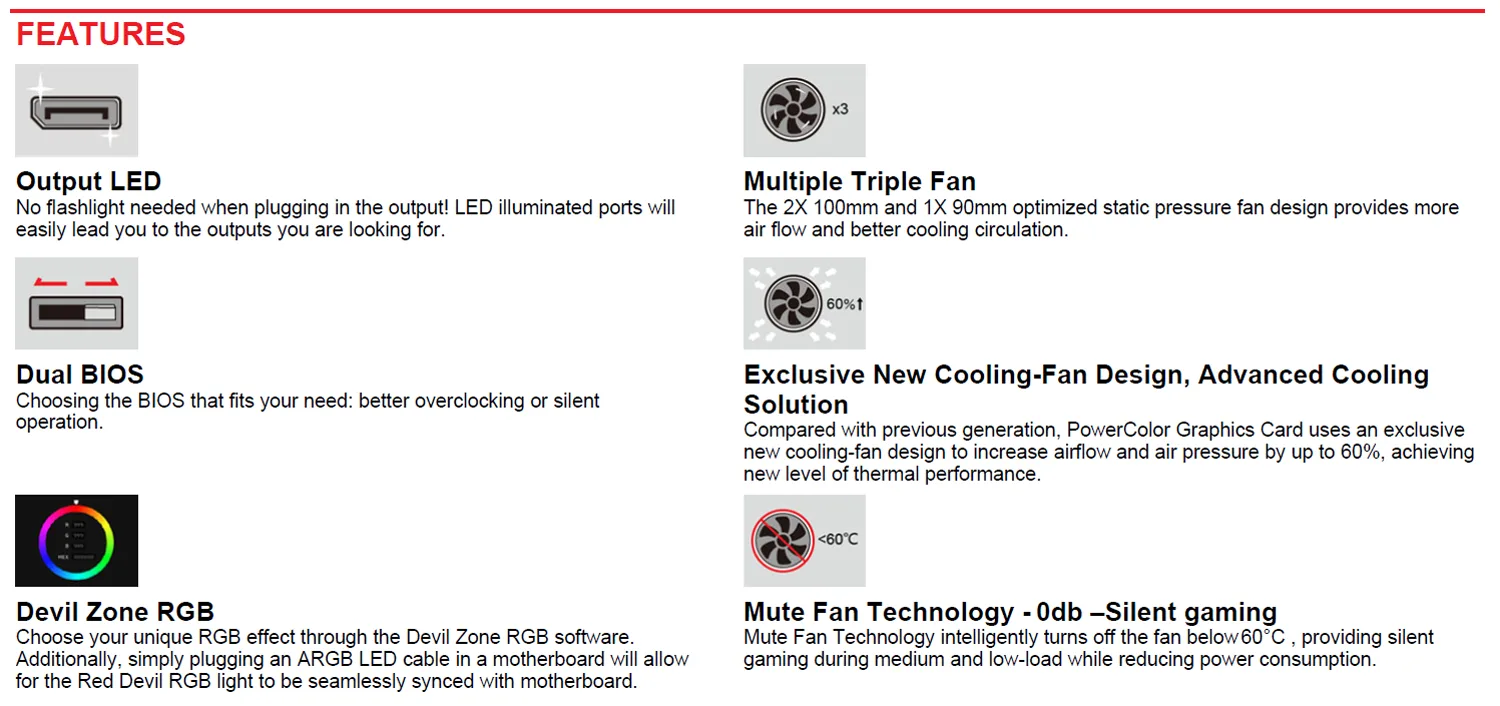
Additional Information from PowerColor
- The Red Devil has 2 modes, OC and Silent with a BIOS switch on the side of the card. Even on performance mode it’s said to be considerably quieter than reference board and the silent mode is indeed very quiet.
- The board has 16 Phase versus the 11+2 Phase VRM design on the reference design. Red Devils are over-spec’d in order to deliver the best stability and overclocking headroom. It’s not only capable of using well over 400w, but by having the best VRMs, it will run cooler and last longer.
- DrMos and high-polymer Caps are used without any compromise.
- The cooler features 2 x 100mm with a center 1x90mm fan, all with two ball bearing fans with 7 heat pipes (3X8Φ and 4X6Φ heatpipes) across a high density heatsink with a copper base. The PCB is shorter than the cooler.
- The RGB is enhanced and the Red Devil RX 6900 XT connects to the motherboard using aRGB (5V 3-pin connector).
- It uses mute fan technology and the fans stop under 60C.
- The ports are LED illuminated so as to see in the dark where to plug in cables.
- The card back plate does not use thermal pads, rather there are openings across the backplate for the PCB to ‘breathe’.
- Red Devil RX 6900 XT Graphics Card Limited Edition provides unique and high-quality crafted Red Devil keycaps to make your keyboard look Devilish.
- Red Devil RX 6900 XT Graphics Card Limited Edition includes card stands for mounting it and displaying it vertically in your PC.
- Buyers of the Red Devil Limited Edition will be able to join exclusive giveaways as well access to the Devil Club website. A membership club for Devil users only gives them access to news, competitions, downloads and instant support via live chat.
Contrary to social media speculation, the Limited Edition uses the same GPU as the “regular” edition but differentiates itself by bundling two Red Devil keycaps and vertical mounting stands for $40 more. Here are the bundles link.
The Big Navi 2 Radeon 6000 family
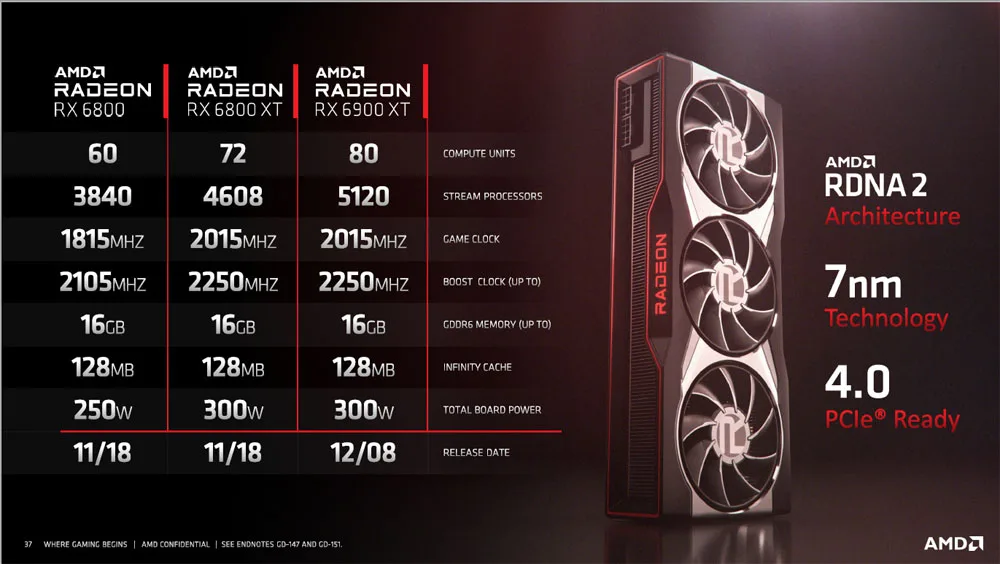 The Radeon 6800 competes with the RTX 3070 and is priced a little higher at $579 while the RTX 6800 XT at $649 competes with the RTX 3080 at $699. The reference RTX 6900 XT released at $999 to compete with the $1499 RTX 3090 and the Red Devil is priced around 15% more than the reference version.
The Radeon 6800 competes with the RTX 3070 and is priced a little higher at $579 while the RTX 6800 XT at $649 competes with the RTX 3080 at $699. The reference RTX 6900 XT released at $999 to compete with the $1499 RTX 3090 and the Red Devil is priced around 15% more than the reference version.
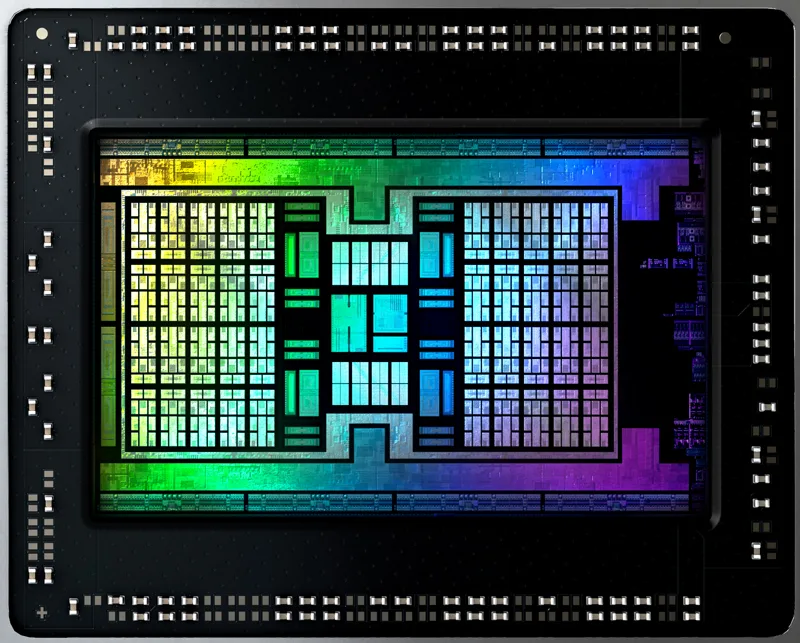
Above is a die shot of the GPU powering the Radeon 6000 series courtesy of AMD.
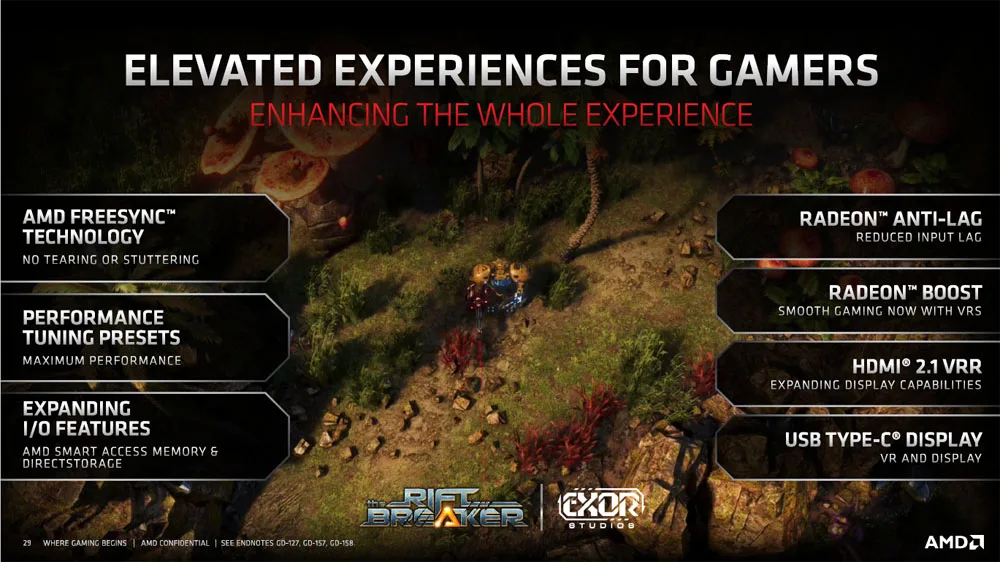
AMD has their own ecosystem for gamers with many unique new features for the Radeon 6000 series including low-latency modes for eSports gamers and FidelityFX upscaling for better image quality without impacting performance. Ray tracing is now featured and premium VR support continues to be supported.
The RX 6900 XT is AMD’s flagship card, and the Red Devil represents one of the best choices for a partner card by virtue of its high-quality components and carefully selected GPUs coupled with good support and great warranty service.
The Test Bed
BTR’s test bed consists of 35 games and 3 synthetic game benchmarks at 1920×1080, 2560×1440, and at 3840×2160 as well as SPEC, Workstation, and GPGPU benchmarks. Our latest games include Cyberpunk 2077, Watch Dogs: Legions, Call of Duty Black Ops: Cold War, Godfall, and Assassin’s Creed: Valhalla, and we will test ray tracing performance in selected games. The testing platform uses a recent clean installation of Windows 10 64-bit Pro Edition, and our CPU is an i9-10900K which turbos all 10 cores to 5.1/5.0GHz, an EVGA Z490 FTW motherboard, and 32GB of T-FORCE Dark Z DDR4 3600MHz. The games, settings, and hardware are identical except for the cards being compared.
Part 2, coming later this week, will feature 15 VR games’ performance versus the RX 3090, the RTX 3080, and against the RX 6800 XT. Part 3 will feature overclocking and power draw using the same cards.
First, let’s take a closer look at the new PowerColor Red Devil RX 6900 XT.
A Closer Look at the PowerColor Red Devil RX 6900 XT
Although the Red Devil RX 6900 XT advertises itself as a premium 7nm card on AMD’s RDNA 2 architecture which features FidelityFX, FreeSync 2 HDR and PCIe 4.0, the cover of the box uses almost no text in favor of stylized imagery.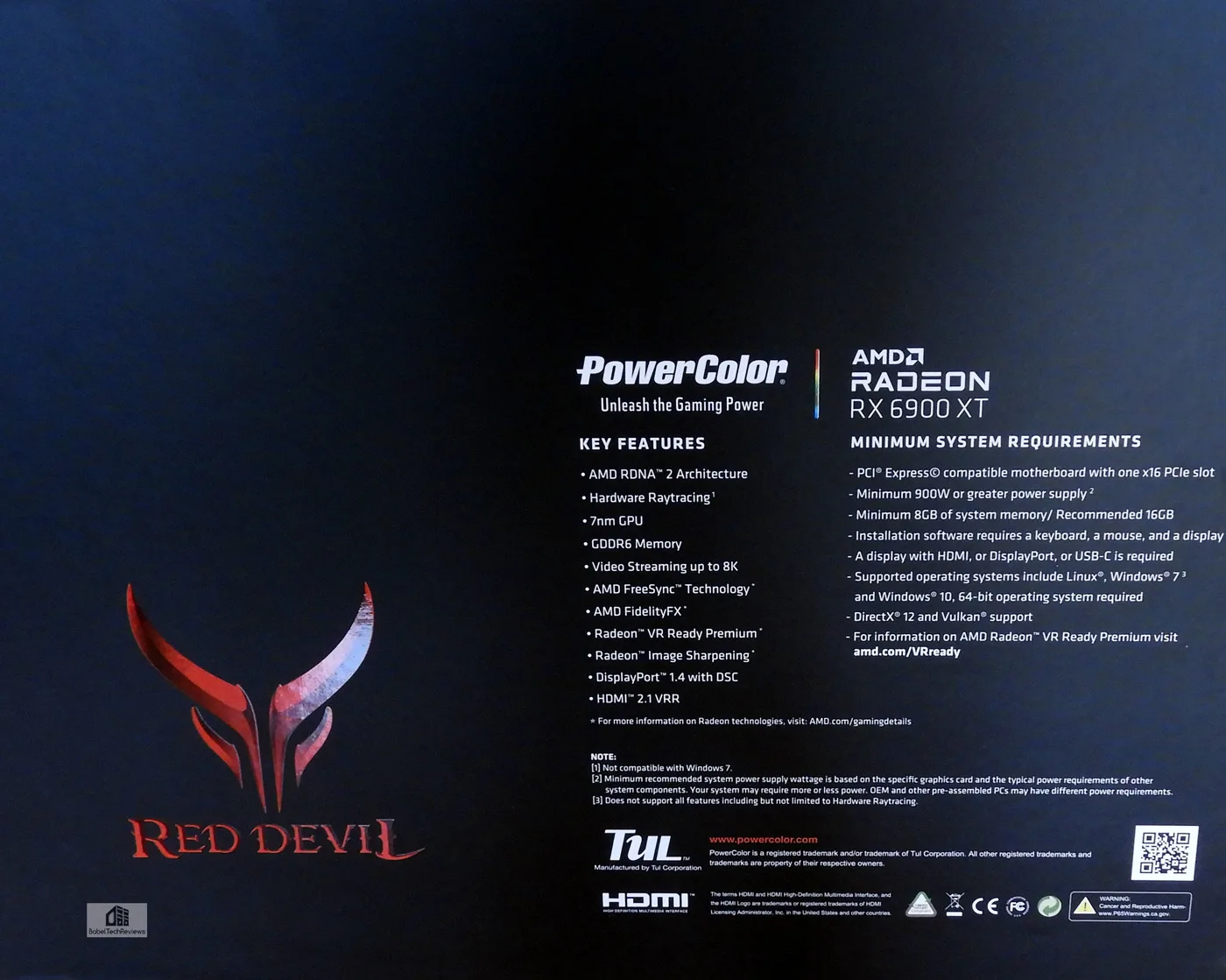
The back of the box touts key features which now include HDMI 2.1 VRR, ray tracing technology, and VR Ready Premium as well as states its 900W power and system requirements although there is a lot of blank space on the box. AMD’s technology features are highlighted, but the box does not even mention PowerColor’s custom cooling solution, Dual-BIOSes, RGB software, output LEDs, and custom lighted backplate.
We don’t see the Red Devil’s features and extreme cooling highlighted until we open the box.
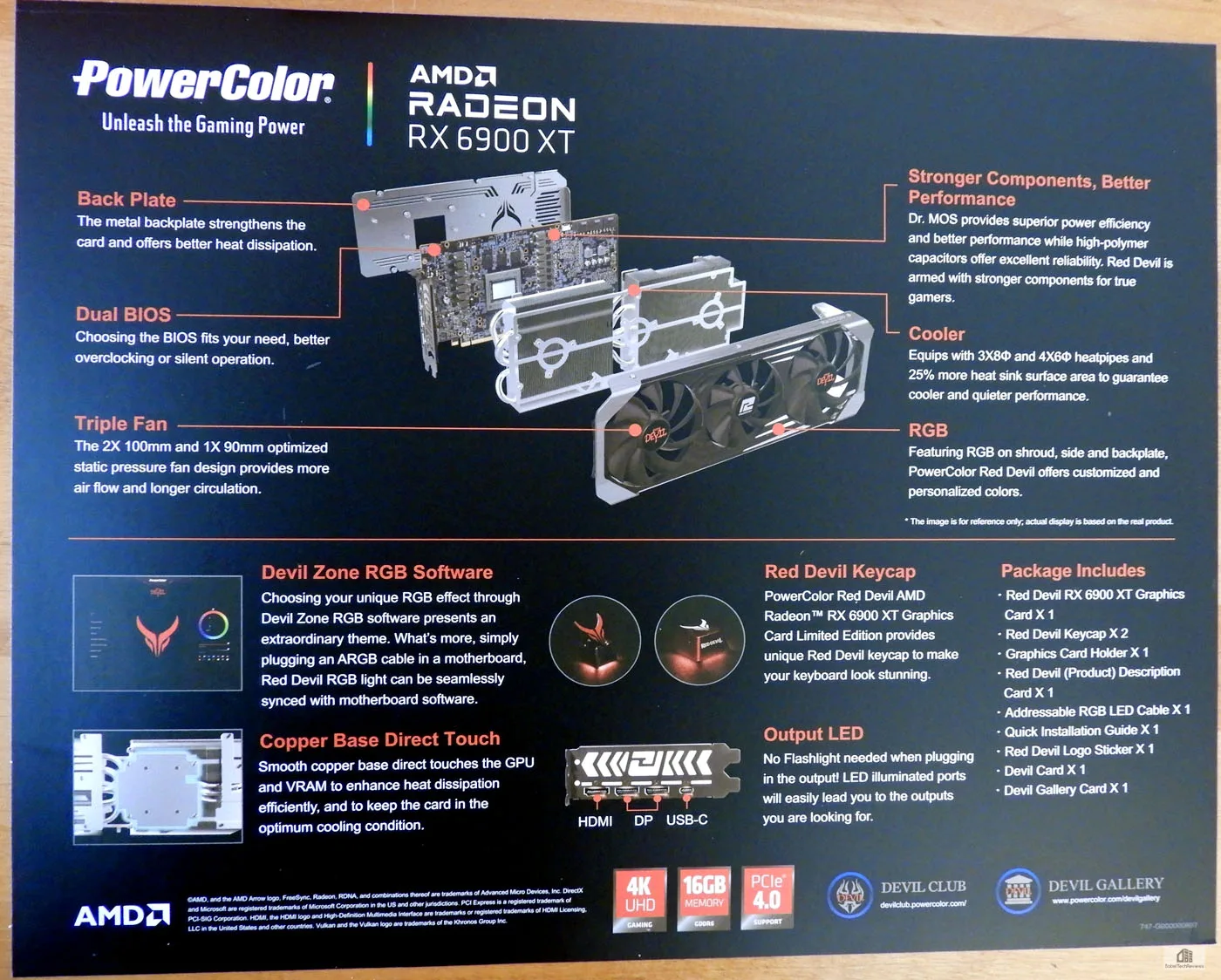
Now we see advertising above that instead probably should have been included on the outside of the box. Also inside are a quick installation guide, RGB LED cable, and an invitation to join PowerColor’s Devil’s Club. The complete package is pictured below.
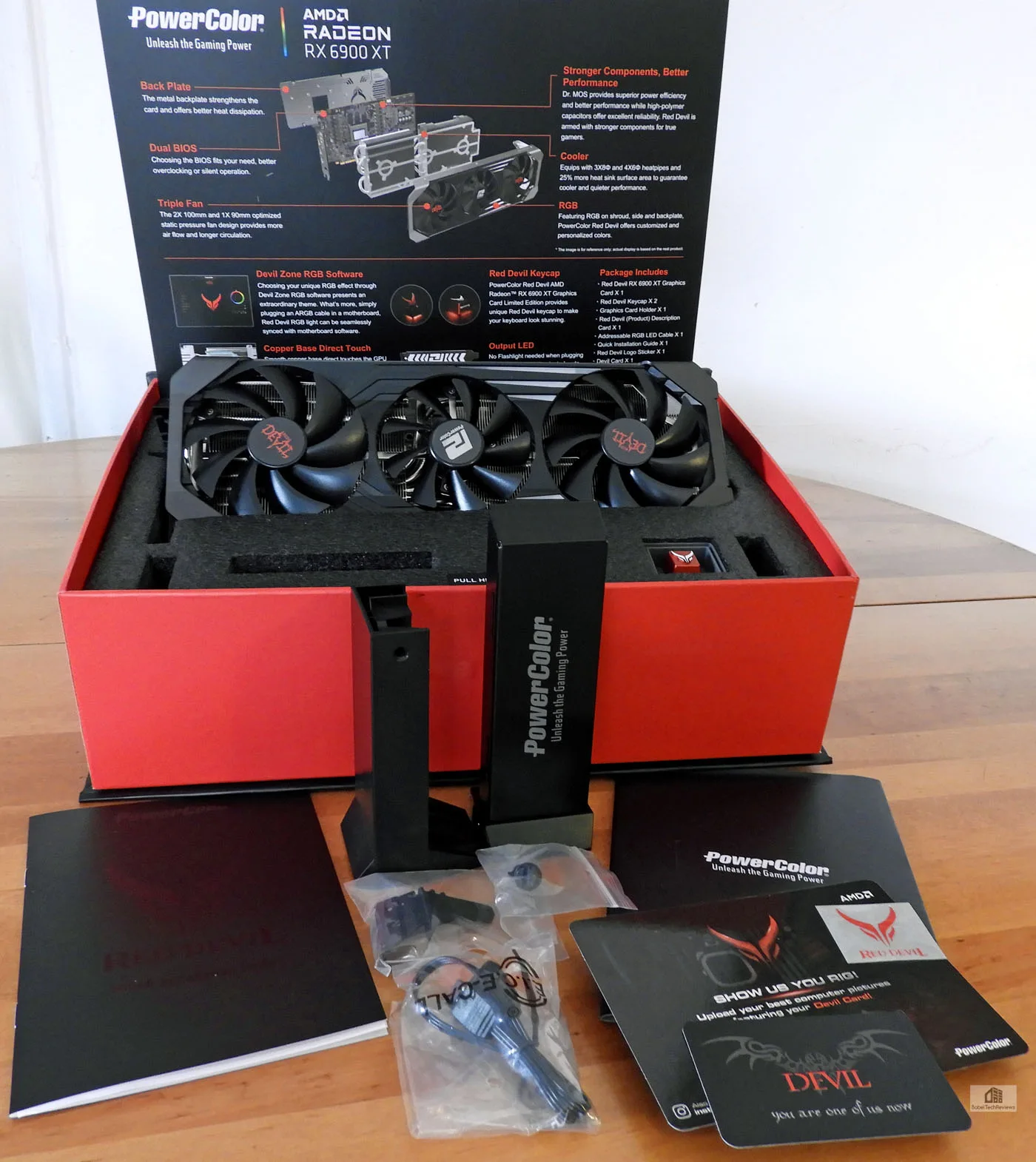 In addition, a couple of key caps are included with the Limited Edition which could prove useful for benchmarking while wearing a HMD, and there are two stands for mounting the Red Devil vertically in a large case. We did not mount the Red Devil vertically as our case is thermally challenged with the side panel closed, and we think it looks nicer mounted horizontally.
In addition, a couple of key caps are included with the Limited Edition which could prove useful for benchmarking while wearing a HMD, and there are two stands for mounting the Red Devil vertically in a large case. We did not mount the Red Devil vertically as our case is thermally challenged with the side panel closed, and we think it looks nicer mounted horizontally.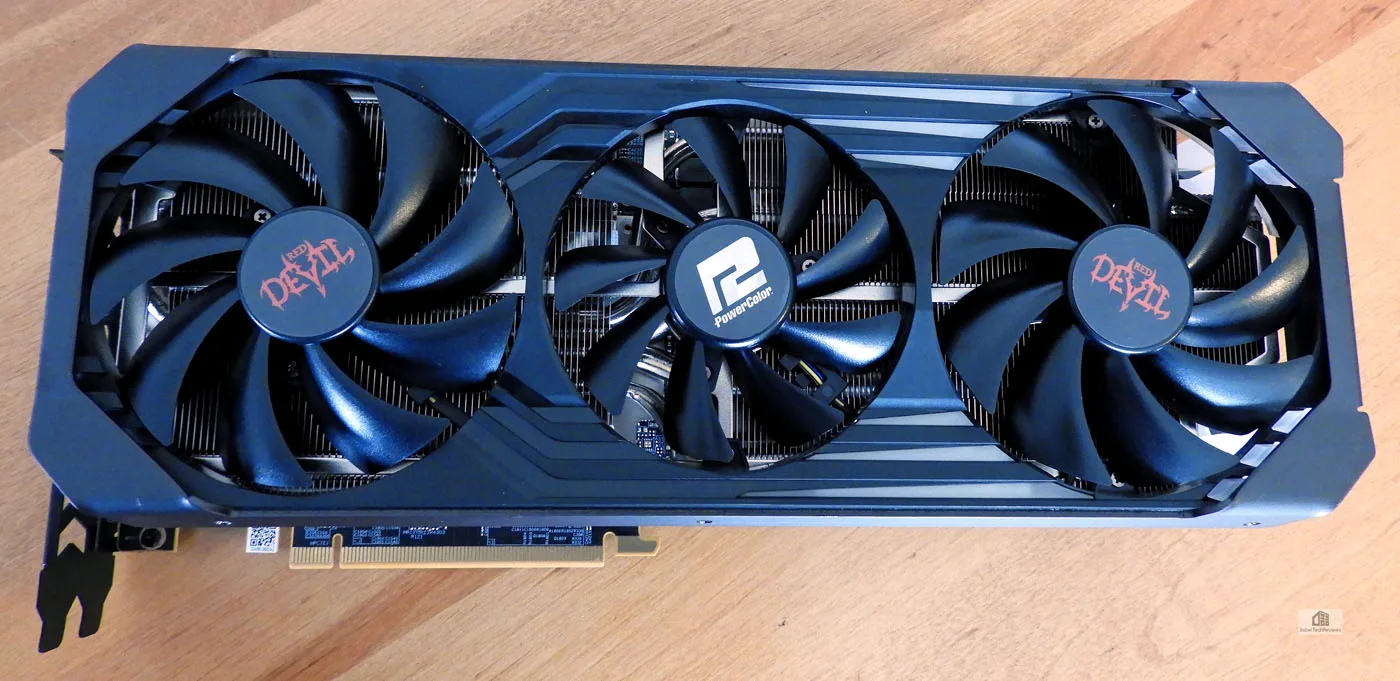
The Red Devil RX 6900 XT is a large tri-fan card in a three slot design which is quite handsome with PowerColor’s colors and even more striking with the RGB on.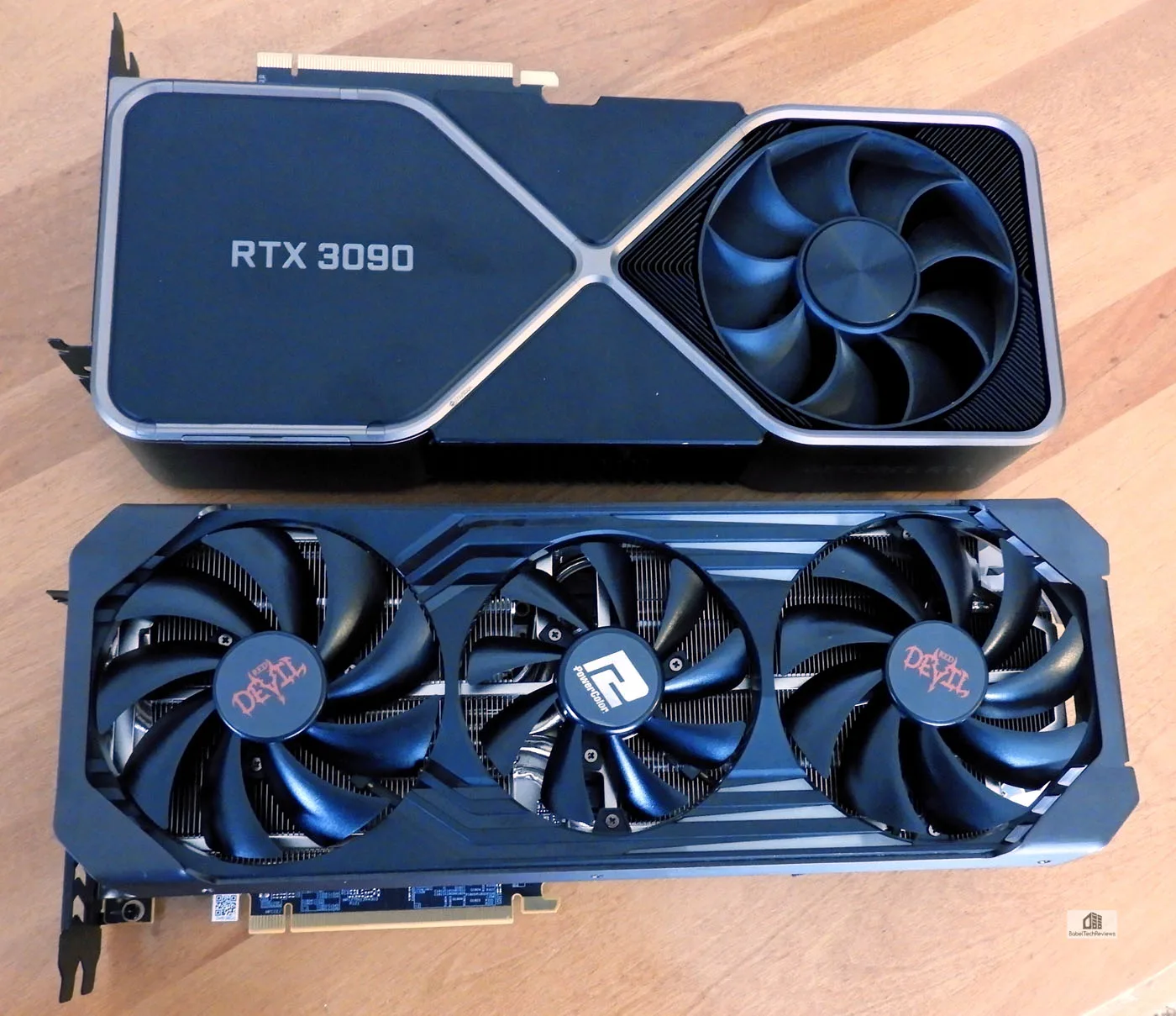
Here is the Red Devil RX 6900 XT pictured next to a RTX 3090 FE above. Both cards are huge compared with either the reference RX 6800 XT or the reference RTX 3080. Although the Red Devil is a little longer than the RX 3090 FE, the GeForce is bulkier and is a bit heavier. Both cards should be locked down with two thumbscrews instead of one because they are both very heavy.
The backplate is beautiful and it uses cutouts for maximum airflow instead of thermal pads. The PowerColor Red Devil RX 6800 XT’s sturdy backplate features a stylized custom devil symbol that lights up in the color of your choice if synced, red being the default. This card is number 467 out of a 500 Limited Edition run. Contrary to social media speculation, the Limited Edition uses the same GPU as the “regular” edition but differentiates itself by bundling two Red Devil keycaps and the vertical mounting stands.
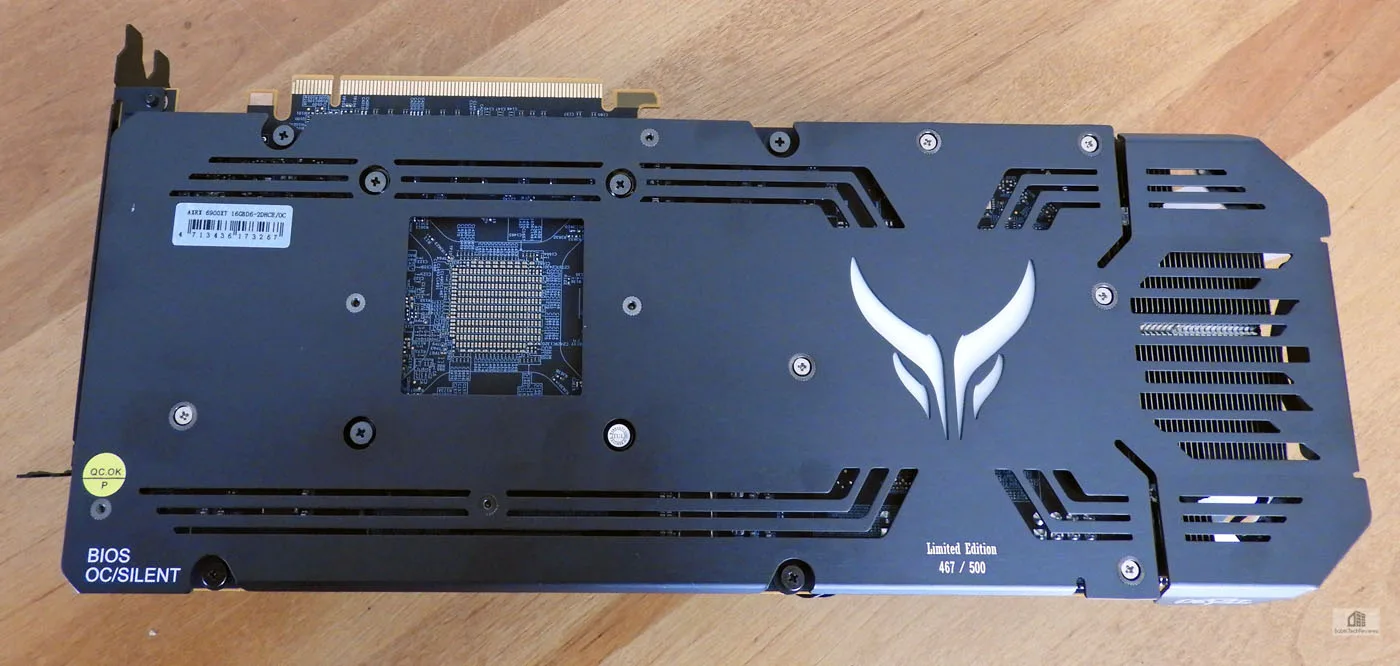
There is also a switch to choose between the default overclock (OC) BIOS and the Silent BIOS. We didn’t bother benching with the Silent BIOS but it is good to have in case a flash goes bad. The Red Devil logo lights up in default red but may be fully customized using the aRGB cable provided.
 The card uses three 1×8-pin PCIe connections and a high capacity PSU is recommended. PowerColor recommends 900W, and we hope to measure the card’s actual power draw in Part 3 of our Red Devil RX 6900 XT review.
The card uses three 1×8-pin PCIe connections and a high capacity PSU is recommended. PowerColor recommends 900W, and we hope to measure the card’s actual power draw in Part 3 of our Red Devil RX 6900 XT review.
The Red Devil’s RX 6900 XT’s connectors include 2 DisplayPorts, 1 HDMI connection, and a USB Type C connector. There is an LED that illuminates this panel for making easier connections in the dark.
Below is the other end where there are additional RGB LEDs that light up the white plastic for a very unique “Red Devil’ look.
 The Red Devil looks outstanding inside a case.
The Red Devil looks outstanding inside a case.
The specifications look good and the card itself looks great with its default RGB bright red contrasting with the black backplate and its aggressively lit-up end, perhaps stylistically reminiscent of an automotive grill.
Let’s check out its performance after we look over our test configuration and more on the next page.
Test Configuration – Hardware
- Intel Core i9-10900K (HyperThreading/Turbo boost On; All cores overclocked to 5.1GHz/5.0Ghz. Comet Lake DX11 CPU graphics)
- EVGA Z490 FTW motherboard (Intel Z490 chipset, v1.9 BIOS, PCIe 3.0/3.1/3.2 specification, CrossFire/SLI 8x+8x), supplied by EVGA
- T-FORCE DARK Z 32GB DDR4 (2x16GB, dual channel at 3600MHz), supplied by Team Group
- Red Devil RX 6900 XT 16GB, stock and overclocked, on short term loan from PowerColor
- Radeon RX 6800 XT Reference version 16GB, stock settings, on loan from AMD
- Radeon RX 6800 Reference version 16GB, stock settings, on loan from AMD
- Radeon RX 5700 XT 8GB Anniversary Edition, stock AE clocks.
- RTX 3080 Founders Edition 10GB, stock, on loan from NVIDIA
- RTX 3090 Founders Edition 24GB, stock clocks, on loan from NVIDIA
- RTX 3070 Founders Edition 8GB, stock clocks, on loan from NVIDIA
- EVGA RTX 3070 FTW3 Ultra 8GB factory clocks, on loan from EVGA
- RTX 2080 Ti Founders Edition 11GB, stock clocks, on loan from NVIDIA
- RTX 2080 SUPER Founders Edition 8GB, stock clocks, on loan from NVIDIA
- RTX 2070 Ti Founders Edition 8GB, stock clocks, on loan from NVIDIA
- GTX 1080 Ti Founders Edition 11GB, stock clocks, on loan from NVIDIA
- 1TB Team Group MP33 NVMe2 PCIe SSD for C: drive
- 1.92TB San Disk enterprise class SATA III SSD (storage)
- 2TB Micron 1100 SATA III SSD (storage)
- 1TB Team Group GX2 SATA III SSD (storage)
- 500GB T-FORCE Vulcan SSD (storage), supplied by Team Group
- ANTEC HCG1000 Extreme, 1000W gold power supply unit
- BenQ EW3270U 32″ 4K HDR 60Hz FreeSync monitor
- Samsung G7 Odyssey (LC27G75TQSNXZA) 27″ 2560×1440/240Hz/1ms/G-SYNC/HDR600 monitor
- DEEPCOOL Castle 360EX AIO 360mm liquid CPU cooler
- Phanteks Eclipse P400 ATX mid-tower (plus 1 Noctua 140mm fan) – All benchmarking and overclocking performed with the case closed
Test Configuration – Software
- GeForce 460.89 used for the RTX 3090 and the RTX 3080
- GeForce 456.96 for the RTX 3070, the RTX 2080 Ti, and the RTX 2070/2080 SUPER; and GeForce 456.16 Press drivers and GeForce 456.38 public drivers (functionally identical) are used for the other GeForce cards. There have been no general game performance driver improvements since Ampere launched.
- Adrenalin 2020 Edition 20.12.2 drivers used for the Red Devil RX 6900 XT and RX 6800 XT; 20.12.1 used for the RX 6800. Adrenalin 2020 Edition 20.10.1 drivers used for the RX 5700 XT Anniversary Edition.
- High Quality, prefer maximum performance, single display, set in the NVIDIA control panel.
- VSync is off in the control panel and disabled for each game
- AA enabled as noted in games; all in-game settings are specified with 16xAF always applied
- Highest quality sound (stereo) used in all games
- All games have been patched to their latest versions
- Gaming results show average frame rates in bold including minimum frame rates shown on the chart next to the averages in a smaller italics font where higher is better. Games benched with OCAT show average framerates but the minimums are expressed by frametimes (99th-percentile) in ms where lower numbers are better.
- Windows 10 64-bit Pro edition; latest updates v2004. DX11 titles are run under the DX11 render path. DX12 titles are generally run under DX12, and multiple games use the Vulkan API.
- Latest DirectX
- MSI’s Afterburner, latest beta
- OCAT
- Fraps
Games
Vulkan
- DOOM Eternal
- Red Dead Redemption 2
- Ghost Recon: Breakpoint
- Wolfenstein Youngblood
- World War Z
- Strange Brigade
- Rainbow 6 Siege
DX12
- Cyberpunk 2077
- Godfall
- Call of Duty Black Ops: Cold War
- Assassin’s Creed: Valhalla
- Watch Dogs: Legion
- Horizon Zero Dawn
- Death Stranding
- F1 2020
- Mech Warrior 5: Mercenaries
- Call of Duty Modern Warfare
- Borderlands 3
- Gears 5
- Tom Clancy’s The Division 2
- Metro Exodus
- Civilization VI – Gathering Storm Expansion
- Battlefield V
- Assetto Corsa: Competitione
- Shadow of the Tomb Raider
- Project CARS 2
- Forza 7
DX11
- Crysis Remastered
- Star Wars: Jedi Fallen Order
- The Outer Worlds
- Destiny 2 Shadowkeep
- Borderlands 3
- Total War: Three Kingdoms
- Far Cry New Dawn
- Monster Hunter: World
- Overwatch
- Grand Theft Auto V
Synthetic
- TimeSpy (DX12)
- 3DMark FireStrike – Ultra & Extreme
- Superposition
- Heaven 4.0 benchmark
- AIDA64 GPGPU benchmarks
- Blender 2.90 benchmark
- Sandra 2020 GPGPU Benchmarks
- SPECworkstation3
- SPECviewperf 2020
NVIDIA Control Panel settings
Here are the NVIDIA Control Panel settings.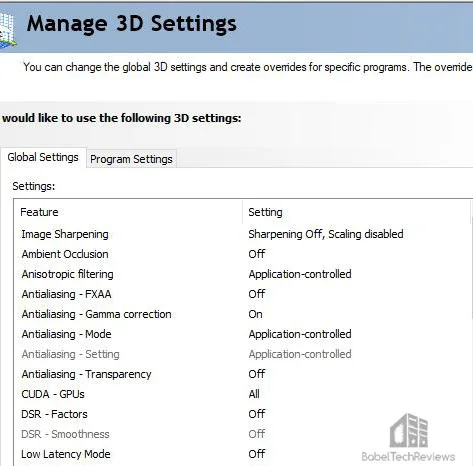


We used MSI’s Afterburner to set all GeForce video cards’ power and temperature limits to maximum and used Wattman for the Radeons.
AMD Adrenalin Control Center Settings
All AMD settings are set so that all optimizations are off, Vsync is forced off, Texture filtering is set to High, and Tessellation uses application settings. All Navi cards are capable of high Tessellation unlike earlier generations of Radeons.
Anisotropic Filtering is disabled by default but we always use 16X for all game benchmarks.
Let’s check out overclocking, temperatures and noise next.
Overclocking, temperatures and noise
We didn’t spend any time overclocking the Red Devil RX 6900 XT for this review as it will be covered in Part 3 later this week (after VR), and we plan to measure the power that the card actually draws compared with the RTX 3090. The card is very quiet and its fans never spin up even under a heavy load so as to be irritating or even noticeable. It is even a bit quieter than the RTX 3090 which is a relatively quiet flagship card – especially compared with the Turing flagship (RTX 2080 Ti).
The Red Devil RX 6900 XT is factory clocked 90MHz higher than the reference version at 2250MHz using the OC BIOS. According to its specifications, the Red Devil RX 6900 XT boost can clock up to 2340MHz out of the box. From our benching, we generally see it boosting even higher and it generally settles in above 2380MHz with peaks above 2400MHz.
Above are the PowerColor Red Devil RX 6900 XT Wattman default settings including the the power limit set to default while running a 98% GPU load while looping the maxed-out Heaven 4.0 benchmark. For this card, the performance didn’t matter whether the power limit was set to default or higher.
The Red Devil’s temperatures stay low in the mid-70s C with the fans quietly running well below 50% even using the OC BIOS under a full gaming load. It is an exceptionally well-cooled card.
Let’s head to the performance charts to see how the performance of the Red Devil RX 6900 XT compares with 11 other cards.
Performance Summary Charts
Here are the performance results of 35 games and 3 synthetic tests comparing the Red Devil RX 6900 XT 16GB with the RTX 3090 FE 24GB, and also compared versus RTX 3080 FE 10GB and versus the reference RTX 6800 XT 16GB, all at their factory set clocks. The highest settings are used and are listed on the charts. The benches were run at 1920×1080, 2560×1440, and 3840×2160. Click on each chart to open in a pop-up for best viewing.
Most gaming results show average framerates in bold text, and higher is better. Minimum framerates are next to the averages in italics and in a slightly smaller font. The games benched with OCAT show average framerates but the minimums are expressed by frametimes in ms where lower numbers are better.
The Red Devil RX 6900 XT vs. the RTX 3090 FE and vs. t he reference RX 6800 XT and the RTX 3080
The first set of charts show the four main competing cards. Column one represents the $1179 Red Devil RX 6900 XT performance next to the RTX 3090 FE, its $1499 primary competitor, in the second column. The RX 6800 XT reference version ($649) performance results are in column 3, and column four gives the RTX 3080 FE ($699) performance results. 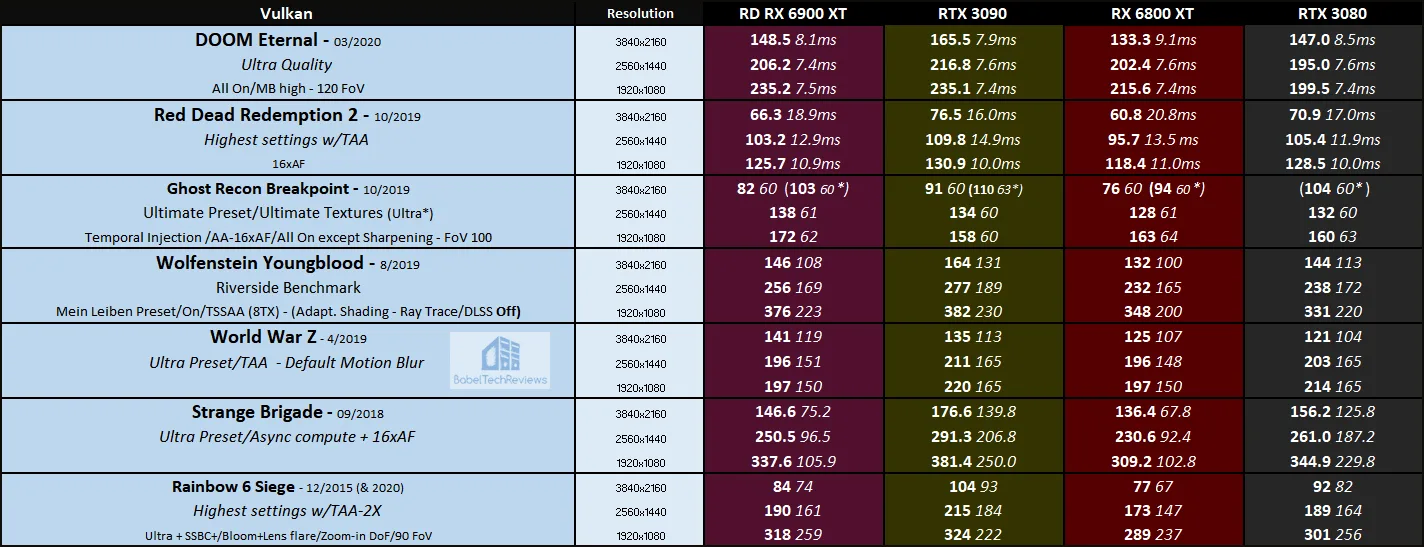


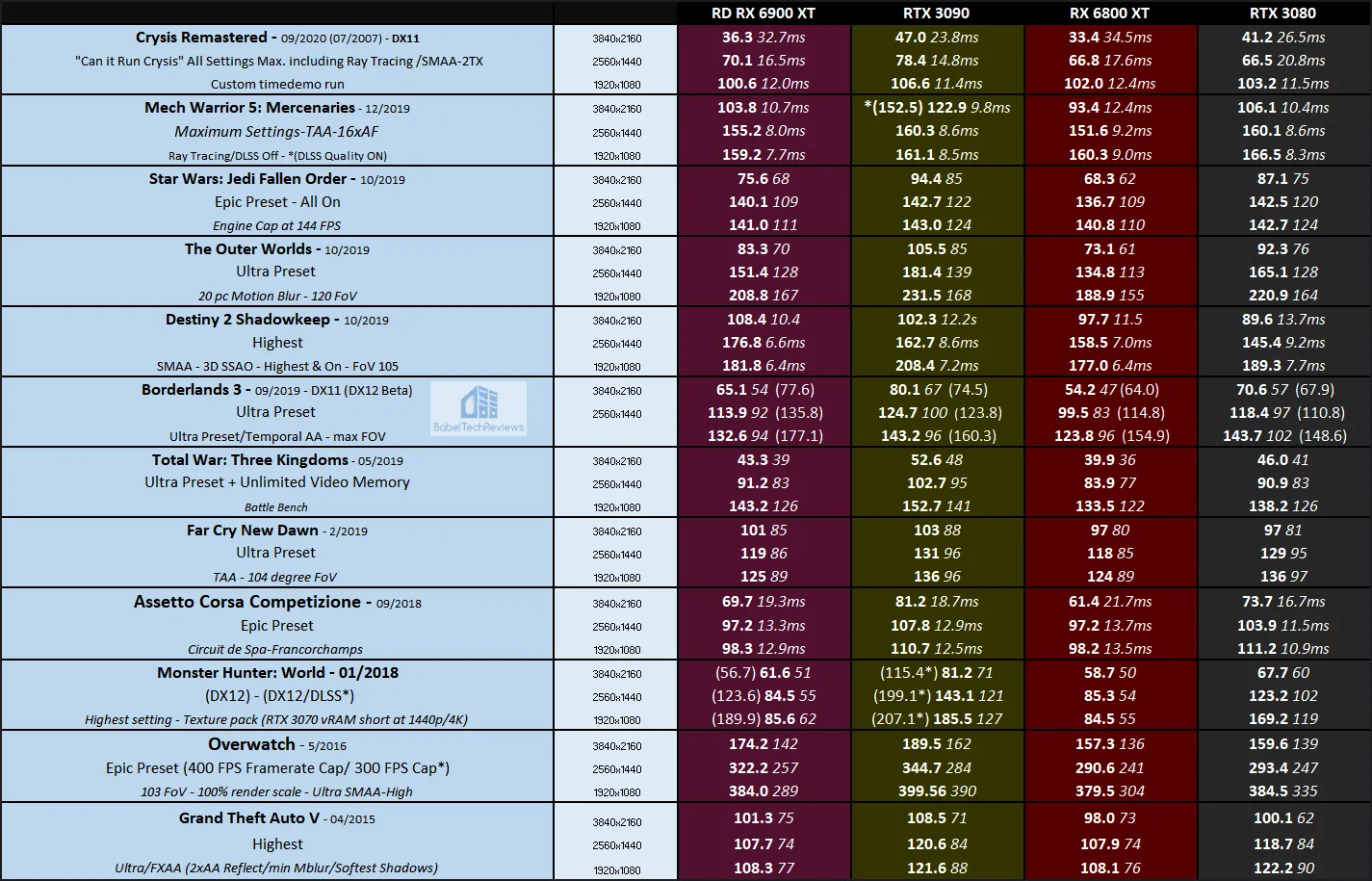
 The Red Devil RX 6900 XT and the RTX 3090 are cards that are primarily suited for 4K and high-FPS 1440P gaming. There is very little performance uplift at 1920×1080 and we would not recommend these cards for 1080P except for eSports/competitive gamers with highly overclocked CPUs and 360Hz displays. Otherwise, for 1080P, save your money and buy a RTX 6800 XT or a RX 3080 instead.
The Red Devil RX 6900 XT and the RTX 3090 are cards that are primarily suited for 4K and high-FPS 1440P gaming. There is very little performance uplift at 1920×1080 and we would not recommend these cards for 1080P except for eSports/competitive gamers with highly overclocked CPUs and 360Hz displays. Otherwise, for 1080P, save your money and buy a RTX 6800 XT or a RX 3080 instead.
There is a performance improvement of the Red Devil RX 6900 XT above the RX 6800 XT that is usually higher at 4K than at 1440P, but the performance gap is small and generally less than the performance differences between the RTX 3080 and the RTX 3090 at similar resolutions. The RTX 3090 and the RX 6900 XT are flagship halo cards with diminishing performance return value for dollars spent. They will appeal to the AMD gamer or the NVIDIA gamer who wants the “best” performance where money is not an object.
Although the RX 6900 XT and the RTX 3090 trade blows in some games and are in the same class, the GeForce is consistently faster at 1440P and at 4K, but it also costs about $350 more than the Red Devil version and $500 more than the reference version. However, where DLSS – which gives equal or superior IQ to TAA – is available, the RTX 3090 pulls even further away from the RX 6900 XT.
Let’s see how the Red Devil RX 6900 XT fits in with our expanded main summary chart, the “Big Picture”, comparing a total of twelve cards.
The Big Picture
Here we see the Red Devil RX 6900 XT performance compared with eleven other cards on recent drivers.
Next we look at six ray tracing enabled games, each using maximum ray traced settings (and DLSS) where available.
Ray Traced Benchmarks
The Red Devil RX 6900 XT is next compared with nine cards when ray tracing is enabled in six games.
The RX 6900 XT now appears to perform similar to the RTX 2080 Ti/Super class when ray tracing features are enabled in-game for older games like Battlefield V and Shadow of the Tomb Raider or ray tracing “lite” games like Crysis Remastered. With newer games like Watch Dogs Legions (and Cyberpunk 2077), the performance gap grows even larger in favor of the GeForce cards.
The problem is that AMD has no hardware equivalent to NVIDIA’s dedicated AI Tensor cores, so it cannot take advantage of DLSS enabled games which put its ray tracing performance even further behind. However, although AMD has promised a DLSS equivalent in the future, the RTX 6900 XT simply cannot currently compete with the RTX 3090 in ray traced games and it also falls behind RTX 3080 performance.
Let’s look at non-gaming applications next to see if the RX 6900 XT is a good upgrade from the other video cards that we tested starting with Blender.
Blender 2.90 Benchmark
Blender is a very popular open source 3D content creation suite. It supports every aspect of 3D development with a complete range of tools for professional 3D creation.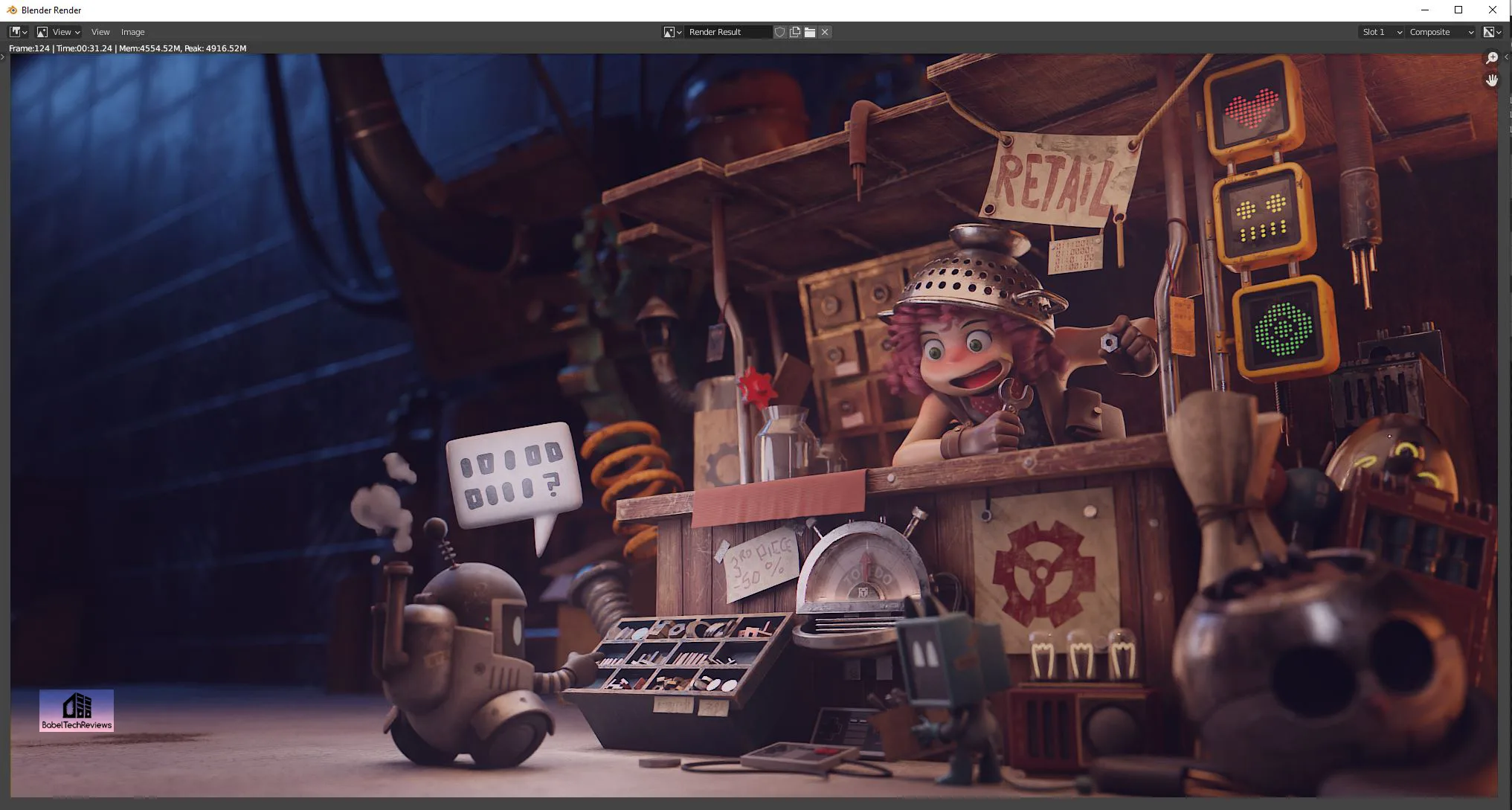
We benchmarked three Blender 2.90 benchmarks which measure GPU performance by timing how long it takes to render production files. We tested seven of our comparison cards using CUDA, Optix, and OpenCL. 
For the following chart, lower is better as the benchmark renders a scene multiple times and gives the results in minutes and seconds.
Blender’s benchmark performance is slower using the RX 6900 XT compared with the RTX 3090.
Next, we move on to AIDA64 GPGPU benchmarks.
AIDA64 v6.25
AIDA64 is an important industry tool for benchmarkers. Its GPGPU benchmarks measure performance and give scores to compare against other popular video cards.
AIDA64’s benchmark code methods are written in Assembly language, and they are well-optimized for every popular AMD, Intel, NVIDIA and VIA processor by utilizing the appropriate instruction set extensions. We use the Engineer’s full version of AIDA64 courtesy of FinalWire. AIDA64 is free to to try and use for 30 days. CPU results are also shown for comparison with both the RTX 3070 and GTX 2080 Ti GPGPU benchmarks.
Here are the Red Devil RX 6900 XT AIDA64 GPGPU results compared with an overclocked i9-10900K.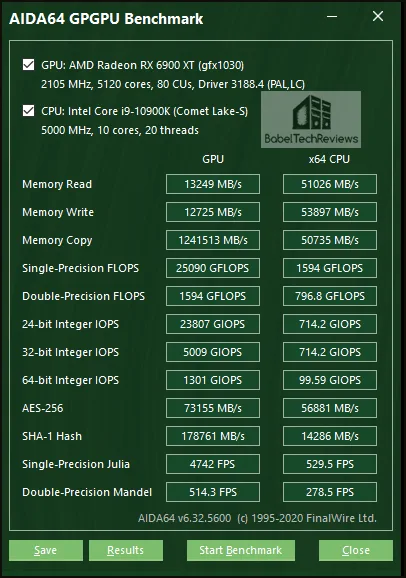
Here is the chart summary of the AIDA64 GPGPU benchmarks with seven of our competing cards side-by-side. Please note that the very latest version of AIDA64 was used to compare the RTX 3090 with the RX 6900 XT while the other cards were tested on older versions.
The RX 6900 XT is a fast GPGPU card and it compares favorably with the Ampere cards being weaker in some areas and stronger in others. So let’s look at Sandra 2020 next.
SiSoft Sandra 2020
To see where the CPU, GPU, and motherboard performance results differ, there is no better tool than SiSoft’s Sandra 2020. SiSoftware SANDRA (the System ANalyser, Diagnostic and Reporting Assistant) is a excellent information & diagnostic utility in a complete package. It is able to provide all the information about your hardware, software, and other devices for diagnosis and for benchmarking. Sandra is derived from a Greek name that implies “defender” or “helper”.
There are several versions of Sandra, including a free version of Sandra Lite that anyone can download and use. Sandra 2020 R10 is the latest version, and we are using the full engineer suite courtesy of SiSoft. Sandra 2020 features continuous multiple monthly incremental improvements over earlier versions of Sandra. It will benchmark and analyze all of the important PC subsystems and even rank your PC while giving recommendations for improvement.
The author of Sandra 2020 informed us that while NVIDIA has sent some optimizations, they are generic for all cards, not Ampere specific. The tensors for FP64 & TF32 have not been enabled in Sandra 2020 so GEMM & convolution running on tensors will get faster using Ampere’s tensor cores. BF16 is supposed to be faster than FP16/half-float, but since precision losses are unknown it has not yet been enabled either. And finally, once the updated CUDA SDK for Ampere gets publicly released, Sandra GPGPU performance should improve also.
With the above in mind, we ran Sandra’s intensive GPGPU benchmarks and charted the results summarizing them. Please note that the very latest version of Sandre 2020 was used to compare the RTX 3090 with the RX 6900 XT while the other cards were tested on older versions.
In Sandra GPGPU benchmarks, since the architectures are different, each card exhibits different characteristics with different strengths and weaknesses. However, we see very solid improvements of the RX 6900 XT over the RX 6800 XT, RX 6800 and the RX 5700 XT.
SPECworkstation3 (3.0.4) Benchmarks
All the SPECworkstation3 benchmarks are based on professional applications, most of which are in the CAD/CAM or media and entertainment fields. All of these benchmarks are free except for vendors of computer-related products and/or services.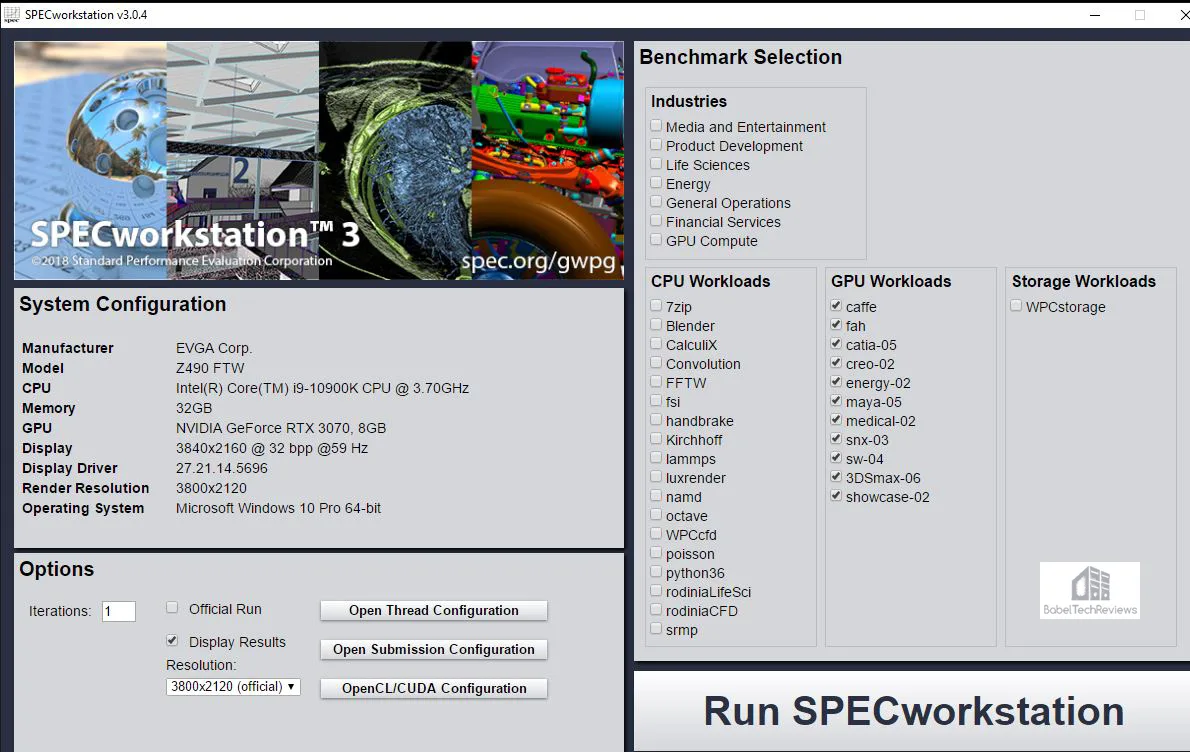
The most comprehensive workstation benchmark is SPECworkstation3. It’s a free-standing benchmark which does not require ancillary software. It measures GPU, CPU, storage and all other major aspects of workstation performance based on actual applications and representative workloads. We only tested the GPU-related workstation performance as checked in the image above.
Here are our raw SPECworkstation 3.0.4.summary and raw scores for the Red Devil RX 6900 XT.
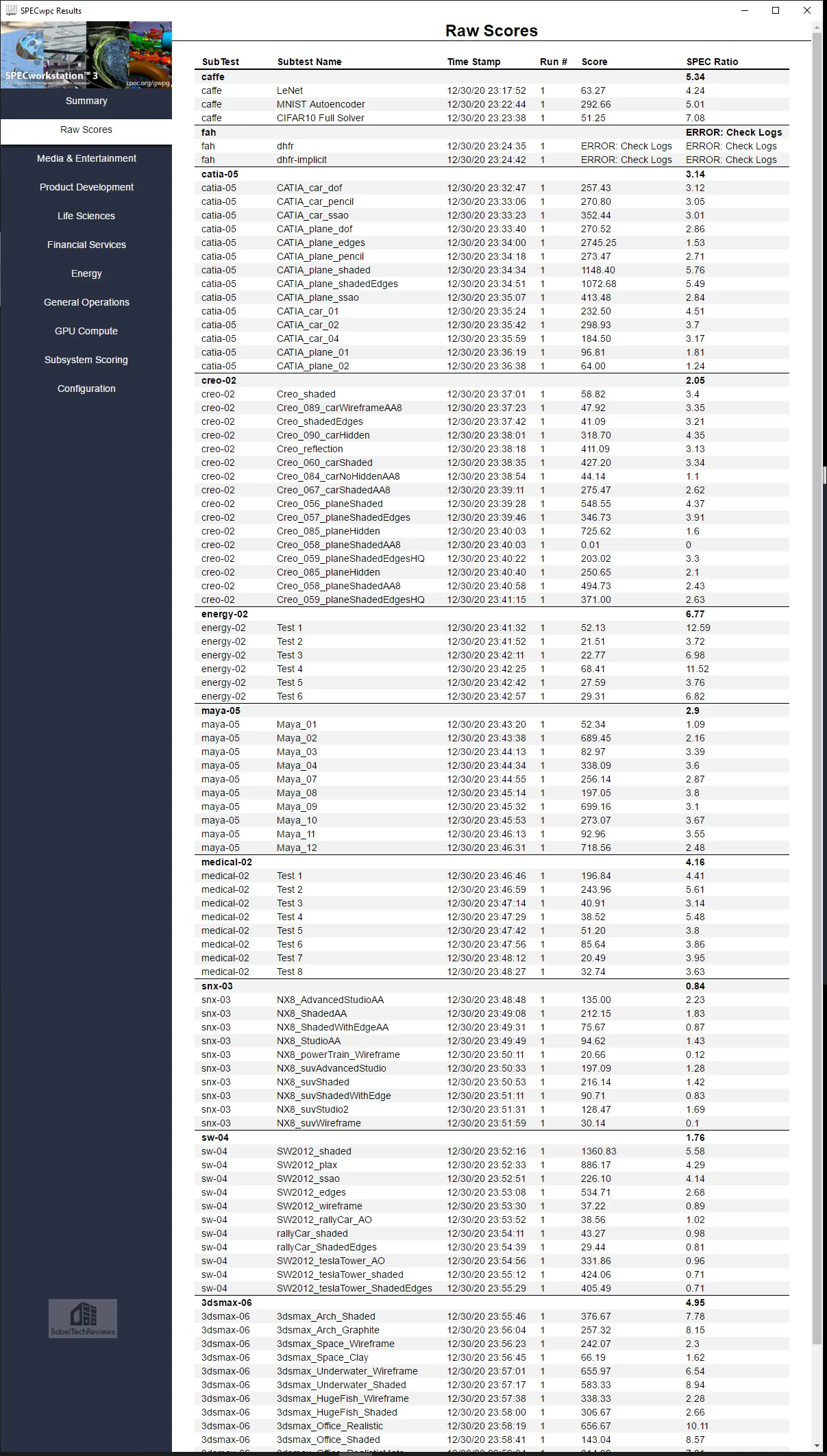

Here are the Red Devil SPECworkstation3 results summarized in a chart along with nine competing cards. Higher is better.
Using SPEC benchmarks, since the architectures are different, the cards each exhibit different characteristics with different strengths and weaknesses.
SPECviewperf 2020 GPU Benches
The SPEC Graphics Performance Characterization Group (SPECgpc) has released a new 2020 version of its SPECviewperf benchmark recently that features updated viewsets, new models, support for both 2K and 4K display resolutions, and improved set-up and results management.
We benchmarked at 4K and here are the summary results for the Red Devil RX 6900 XT.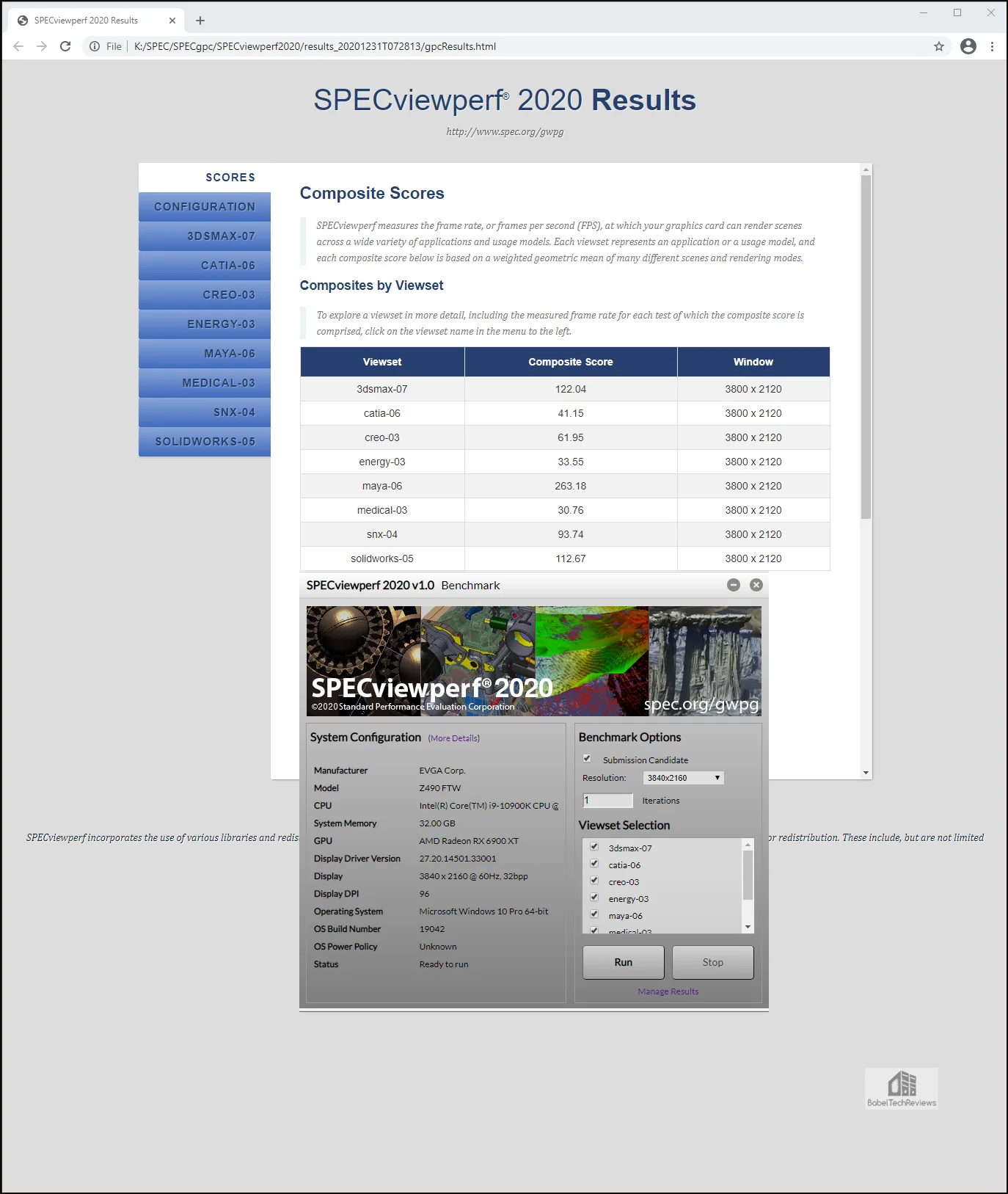
Here are SPECviewperf 2020 Red Devil RX 6900 XT benchmarks summarized in a chart together with eight other cards.

Again we see different architectures with different strengths and weaknesses. After seeing these benches, some creative users may upgrade their existing systems with a new card based on the performance increases and the associated increases in productivity that they require. The RTX 3090 is generally a faster card as it was also tuned for some creative applications whereas the RX 6900 XT is more of a pure gaming card.
The question to buy a new video card should be based on the workflow and requirements of each user as well as their budget. Time is money depending on how these apps are used. However, the target demographic for the reference and Red Devil RX 6900 XTs are primarily gaming for gamers.
Let’s head to our conclusion.
The Conclusion
The Red Devil RX 6900 XT improves significantly over the last generation RX 5700 XT, easily exceeds RX 6800 XT performance, and it trades blows with the RTX 3090 FE in rasterized games although overall it is slower. The Red Devil RX 6900 XT beats all of the last generation cards including the RTX 2080 Ti although it struggles with ray traced games especially when DLSS is used for the GeForce cards.
For Radeon gamers, the reference RX 6900 XT is a good alternative to GeForce Ampere cards for the vast majority of modern PC games that use rasterization. The RX 6900 XT offers 16GB of GDDR6 to the 24GB of GDDR6X that the RTX 3090s are equipped with, but that 8GB of vRAM shouldn’t make any practical difference to game performance.
At its suggested price of $1139 ($1179 for the Limited Edition bundle), the Red Devil RX 6900 XT costs about $350 less than the RTX 3090 FE and offers a good value for Radeon gamers – if it can be found. Unfortunately, the Radeon 6000 series launch has proved to be an extremely high demand and limited supply event that has been called a paper launch by many wishing to purchase one. The same thing has happened to Ampere cards where the stock is still trickling in and being purchased the instant it’s available, often by cyptocurrency miners or for resale. So prices are high and many resellers are taking advantage of this demand situation by raising prices significantly.
Comparing the $1000+ RX 6900 XT to the $650 RX 6800 XT, we conclude that this halo flagship card is not good bang-for-buck – no halo card is. The RTX 3090 at $1500 is not a good value either compared with the performance of the RTX 3080 at $699. The primary difference is that the RTX 3090 holds the performance crown and there are gamers who absolutely will not settle for anything but the “fastest” that these flagship cards are aimed at. The RTX 3090 and the RX 6900 XT are flagship halo cards with diminishing performance return value for dollars spent. The RTX 6900 XT will appeal to the AMD gamer who wants the “best” performance from a Radeon where money is not an object.
The Red Devil RX 6900 XT is priced approximately 15% higher than the reference version which is more reasonable than the 20% plus premiums that some AIBs demand for their overclocked cards. It is a solid and well-built card, and we would recommend it to any Radeon gamer that is looking for AMD’s best.
The only real issue that we see with Radeon 6000 series cards are that ray traced games will become mainstream now that the consoles have adopted it, and AMD’s solution is inferior to NVIDIA’s dedicated hardware that takes advantage of DLSS AI upscaling that delivers superior performance while preserving or enhancing image quality. On the flip side, there are only 30 DLSS-enable games and very few ray traced games, yet there are thousands of rasterized games where the RTX 6900 XT trades blows with the much more expensive RTX 3090.
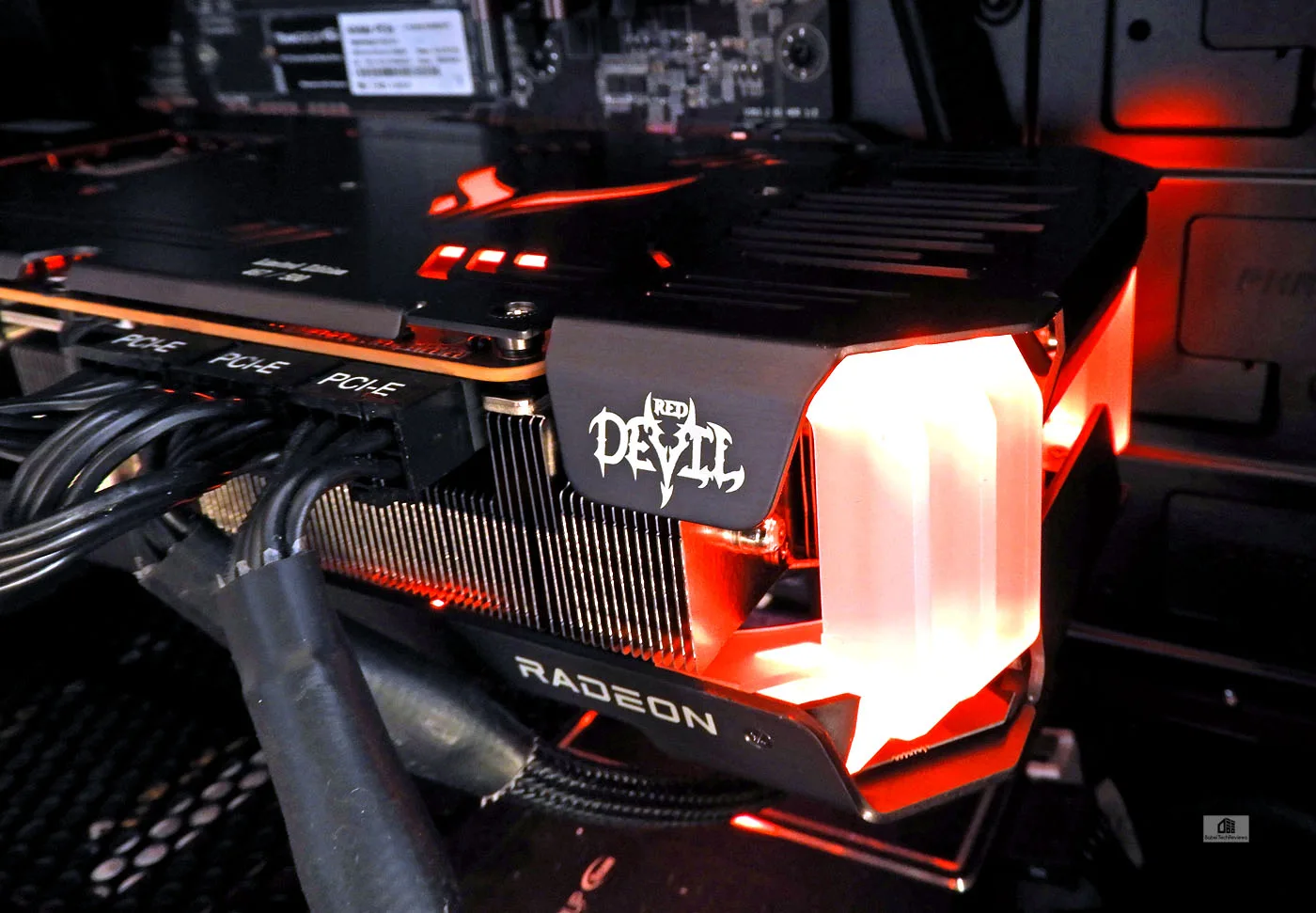
We recommend the Red Devil RX 6900 XT as a great choice out of multiple good choices, especially for any AMD gamer looking for good looks with RGB, an exceptional cooler, great performance for 2560×1440 or 4K, PowerColor’s excellent support, and overall good value compared with the RX 6900 XT reference version assuming that its stock and price stabilize.
Let’s sum it up:
The Red Devil RX 6900 XT Pros
- The PowerColor Red Devil RX 6900 XT is much faster than the last generation RX 5700 series by virtue of new RDNA 2 architecture. It trades blows in the majority of rasterized games with the RTX 3090 FE for significantly less money.
- The Red Devil RX 6900 XT has excellent cooling with very little noise and has a very good power delivery and a 3-fan custom cooling design that is very quiet when overclocked even using the OC mode.
- Dual-BIOS give their user a choice of quiet with less overclocking, or a bit louder with more power-unlimited and higher overclocks.
- FreeSync2 HDR eliminates tearing and stuttering. FidelityFX allows for upscaling and improved sharpness with almost no performance penalty, and there is a low latency mode for competitive gamers
- Customizable RGB lighting and a neutral color allow the Red Devil to fit into any color scheme using the DevilZone software program.
Red Devil RX 6900 XT Cons
- Pricing. It isn’t really that much faster than the reference RX 6800 XT which is almost half of its price
- Weaker ray tracing performance than the RTX 3080 or the RTX 3090
 The Red Devil RX 6900 XT is a good Radeon card choice for those who game at 2560×1440 or at 4K and want the best that AMD has to offer. It represents a good gaming alternative to the RTX 3090 albeit with weaker ray tracing performance. It is offered especially for those who prefer AMD cards and FreeSync2 enabled displays which are generally less expensive than Gsync displays. And if a gamer is looking for something extra above the reference version, the Red Devil RX 6900 XT is a very well-made and good-looking card that will overclock better.
The Red Devil RX 6900 XT is a good Radeon card choice for those who game at 2560×1440 or at 4K and want the best that AMD has to offer. It represents a good gaming alternative to the RTX 3090 albeit with weaker ray tracing performance. It is offered especially for those who prefer AMD cards and FreeSync2 enabled displays which are generally less expensive than Gsync displays. And if a gamer is looking for something extra above the reference version, the Red Devil RX 6900 XT is a very well-made and good-looking card that will overclock better.
We are giving the Red Devil RX 6900 XT an Editor’s Choice. In fact, we have to send this card back to PowerColor this week and will attempt to buy another Red Devil RX 6900 XT from retail for playing games and for further benching. However, we will not pick the Limited Edition if we have a choice since we don’t mount cards vertically.
The Verdict:
- PowerColor’s Red Devil RX 6900 XT is a solidly-built handsome card with higher clocks out of the box than the reference version. It trades blows with the RTX 3090 in rasterized games. I t is a kick ass RX 6900 XT.
Stay tuned, there is much more coming from BTR. Immediately, we will return to VR with a performance evaluation using the Vive Pro comparing the Red Devil RX 6900 XT with the RTX 3090, the RTX 3080, and the 6800 XT. We plan to finish up our 3-part review testing the Red Devil’s overclock and power draw versus the RTX 3090.
It you would like to comment, please use the section below.
Happy Gaming!
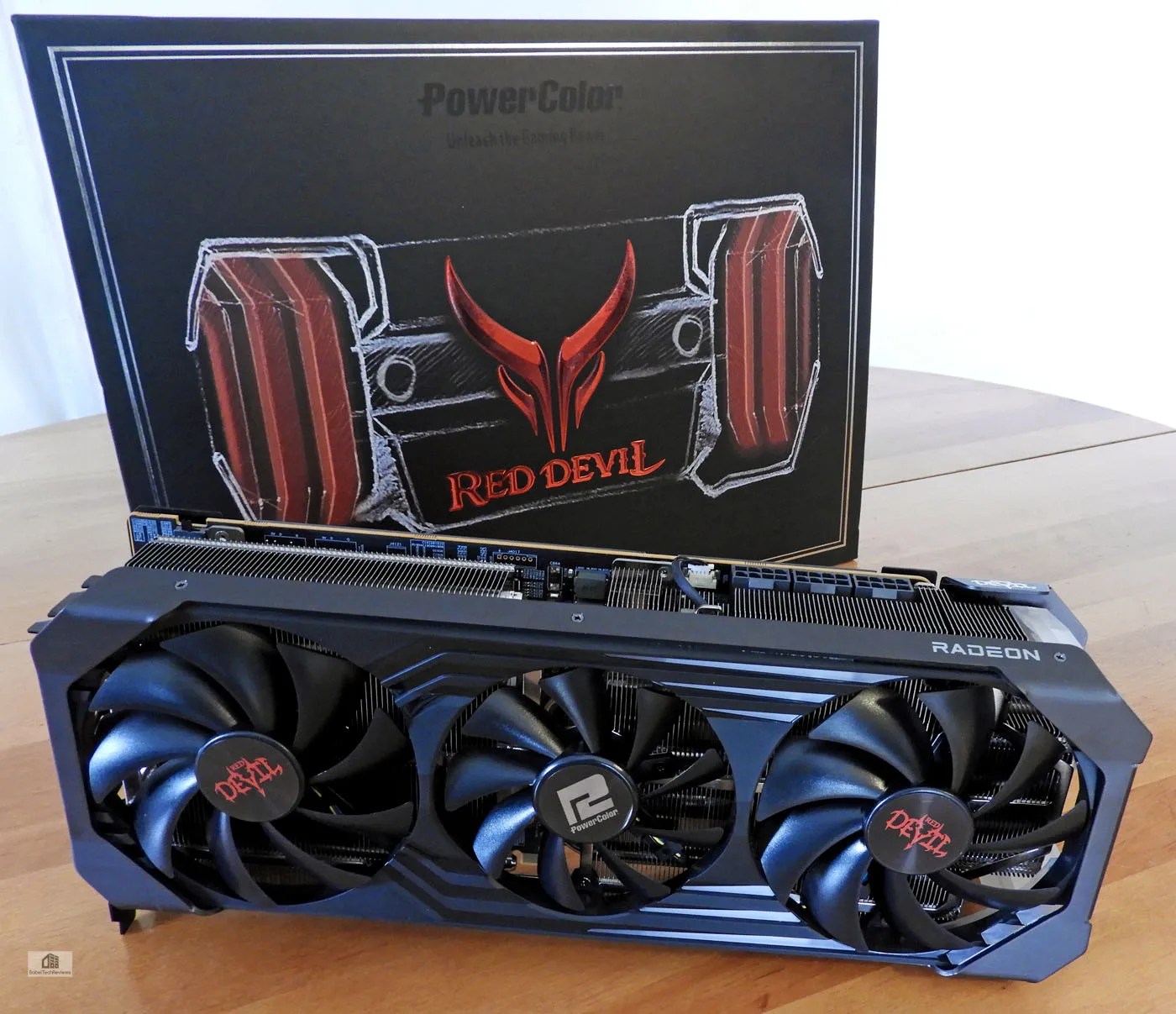

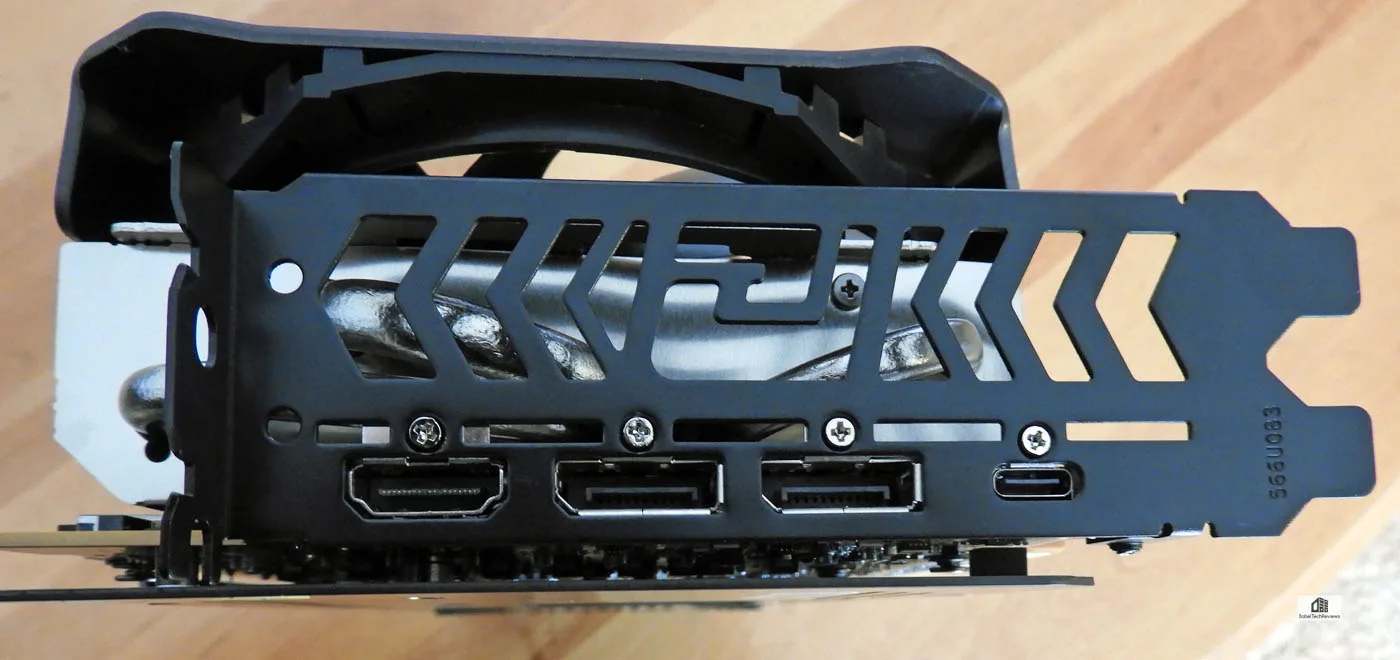

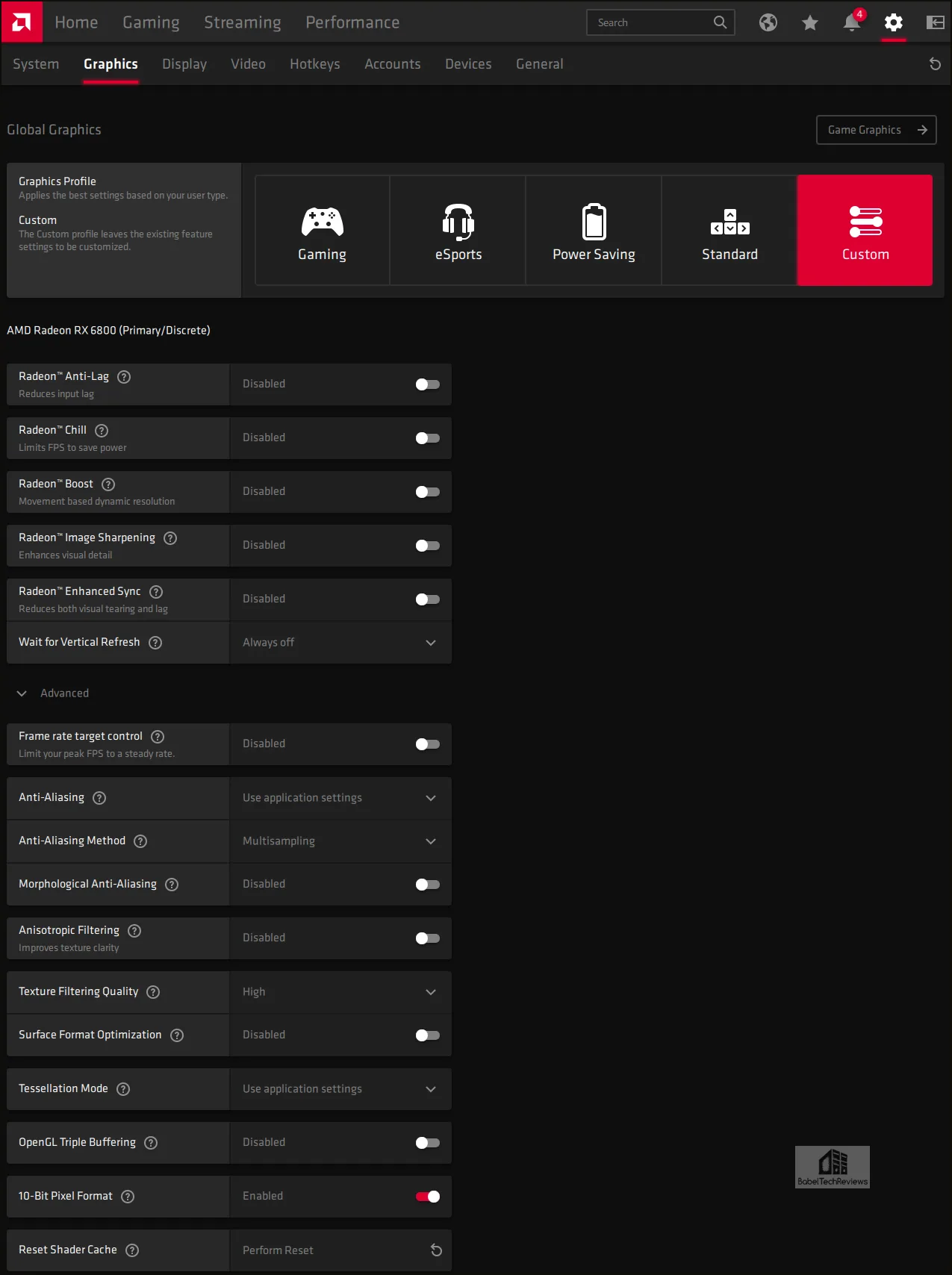
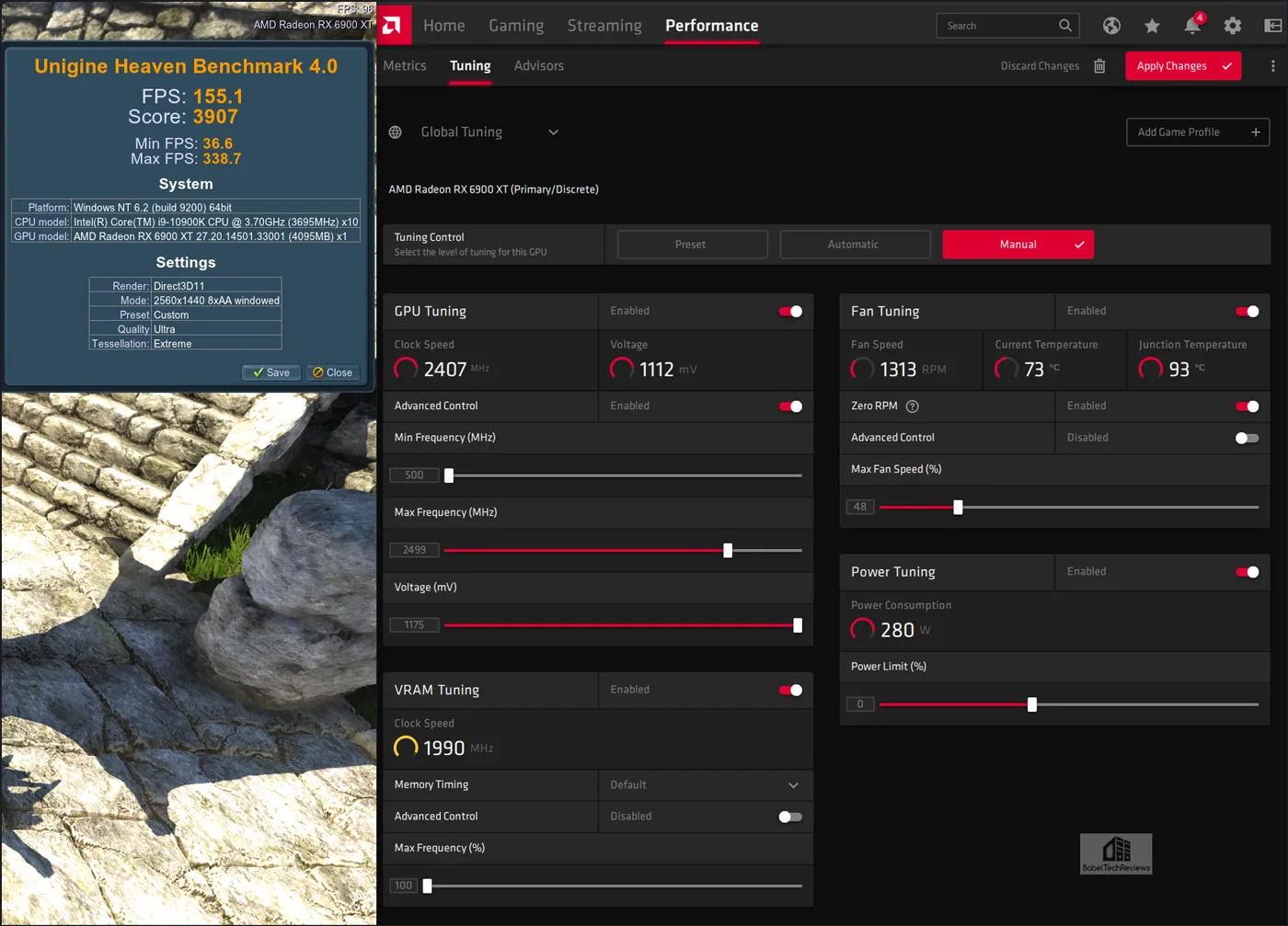








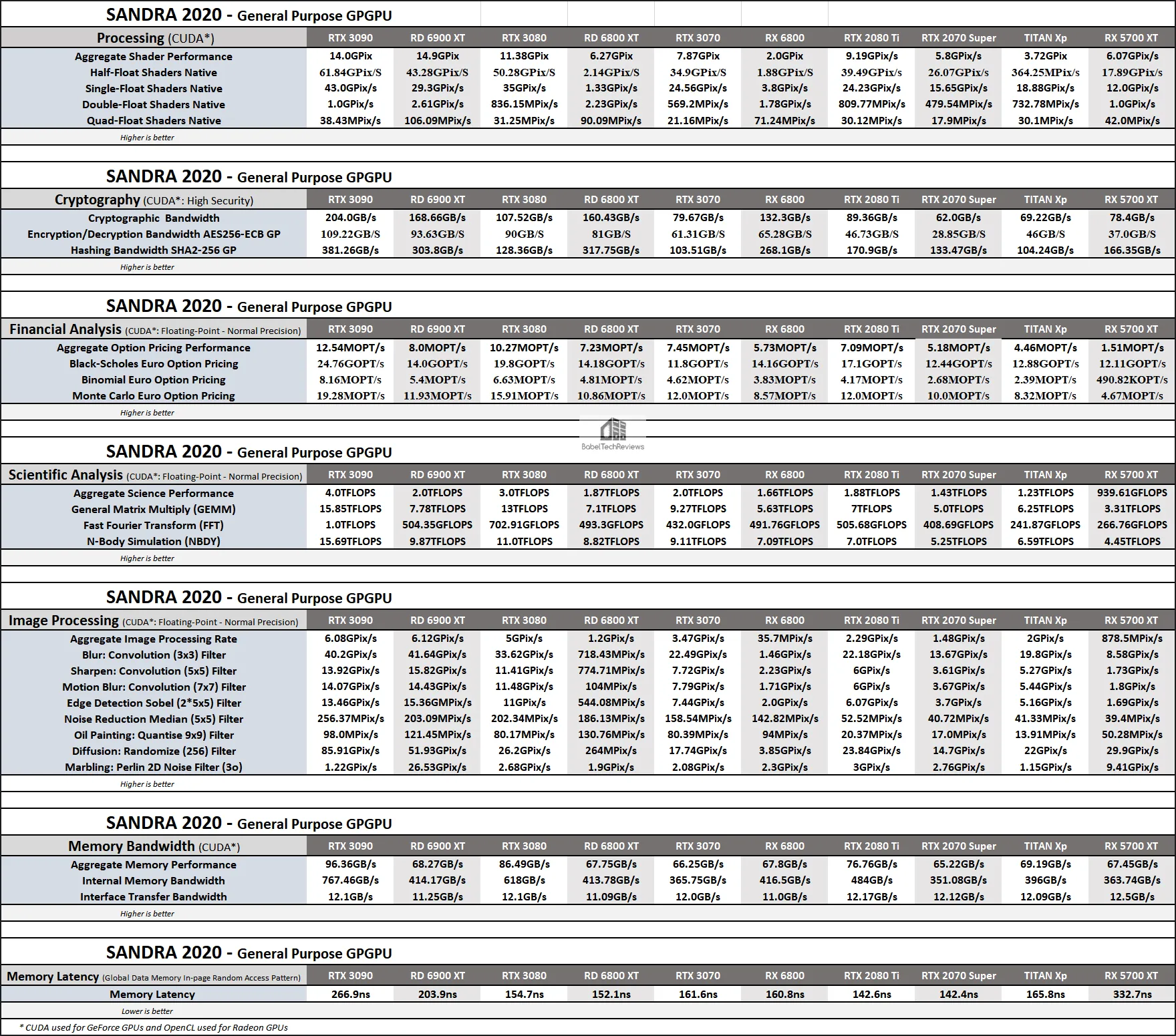
Comments are closed.